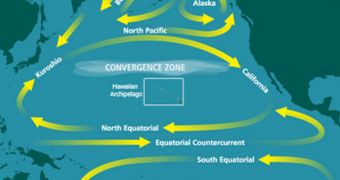The Great Pacific Garbage Patch is already known to researchers as a major threat to the oceanic ecosystem. In the northern parts of the Central Pacific Ocean, currents conglomerate tons upon tons of garbage and wastes, creating artificial islands of junk, and causing many species to die from intoxication with plastics and other dangerous chemicals. At this point, experts warn, a similar formation is taking shape in the North Atlantic Ocean, where similar amounts of junk appear to accumulate unchecked, the BBC News reports.
Naturally, many have begun to compare the two garbage patches, and environmentalists admonish governments for failing to take the necessary measures to prevent these leftovers from reaching the waters in the first place. Nearly everything that falls or gets dumped in the ocean is picked up by currents, which eventually deposit what they carry at the locations where they meet and create large-scale vortices. Sea Education Association expert Kara Lavender Law told the British news agency that the warnings about the possible threats of plastic accumulations in the Atlantic had fallen on deaf ears.
She presented her analysis of the forming north Atlantic garbage patch in Portland, Oregon, at the 2010 Ocean Sciences Meeting of the American Geophysical Union (AGU). The study she and colleagues conducted spans more than two decades of rigorous observations, and so critics will have a hard time trying to debunk these conclusions for self-interest and financial reasons. In fact, this particular research was the longest and most extensive survey of plastic debris in any ocean, ever. Research vessels were used to drag nets across the surface of the water, sampling the seas and analyzing the existing amounts of plastic in each of the areas.
The expert told scientists at the conference that the largest concentration was identified at a location where the researchers discovered as much as 200,000 pieces of plastic junk over a square kilometer. “That's a maximum that is comparable with the Great Pacific Garbage Patch. You can think of it in a similar way [to the Pacific Garbage Patch], but I think the word 'patch' can be misleading. This is widely dispersed and it's small pieces of plastic. But we know that many marine organisms are consuming these plastics and we know this has a bad effect on seabirds in particular,” Lavender Law concludes.

 14 DAY TRIAL //
14 DAY TRIAL //